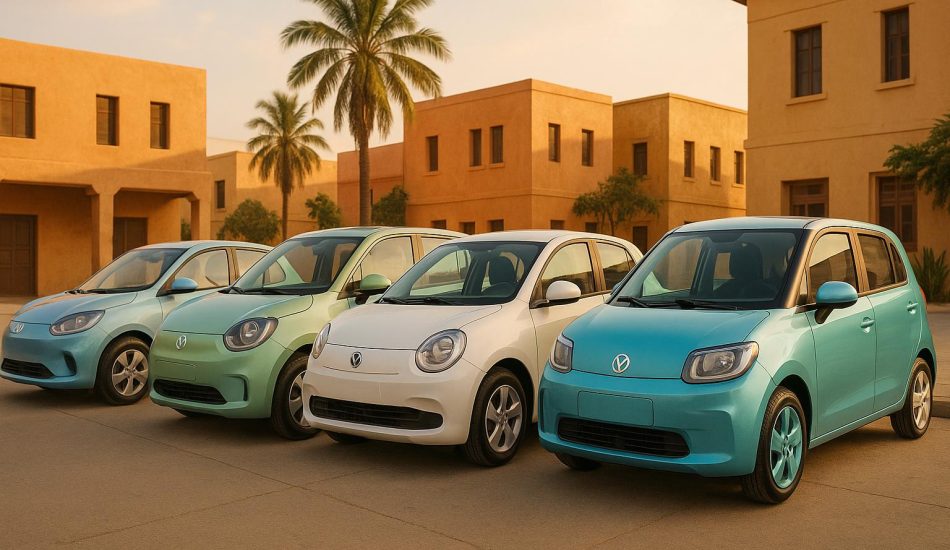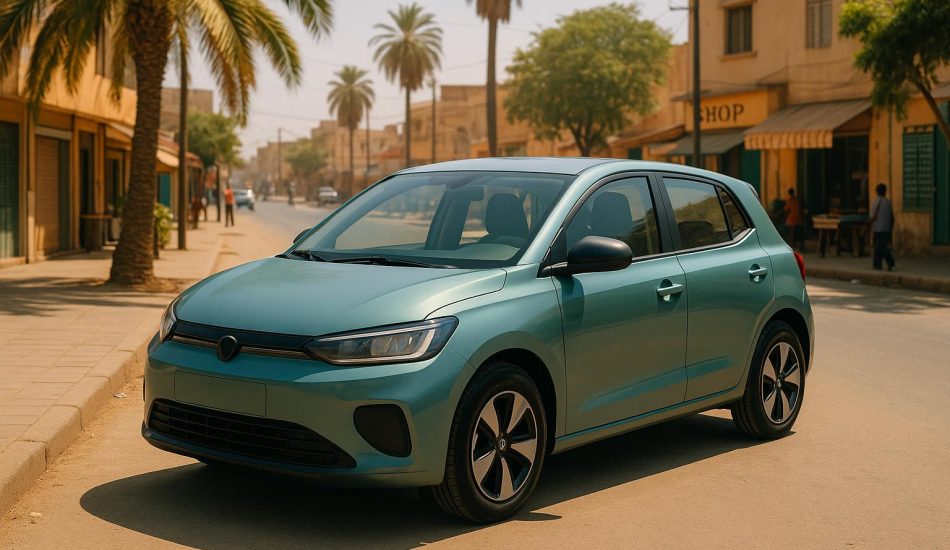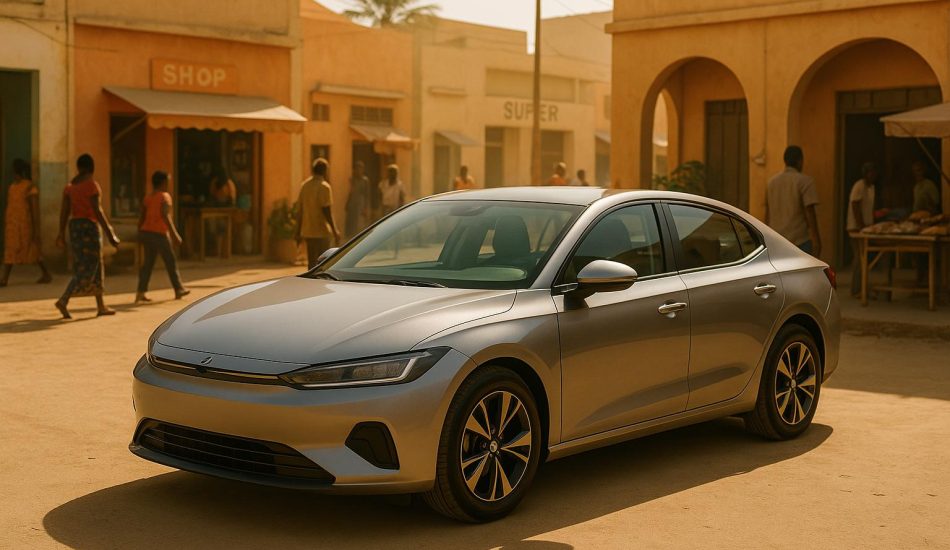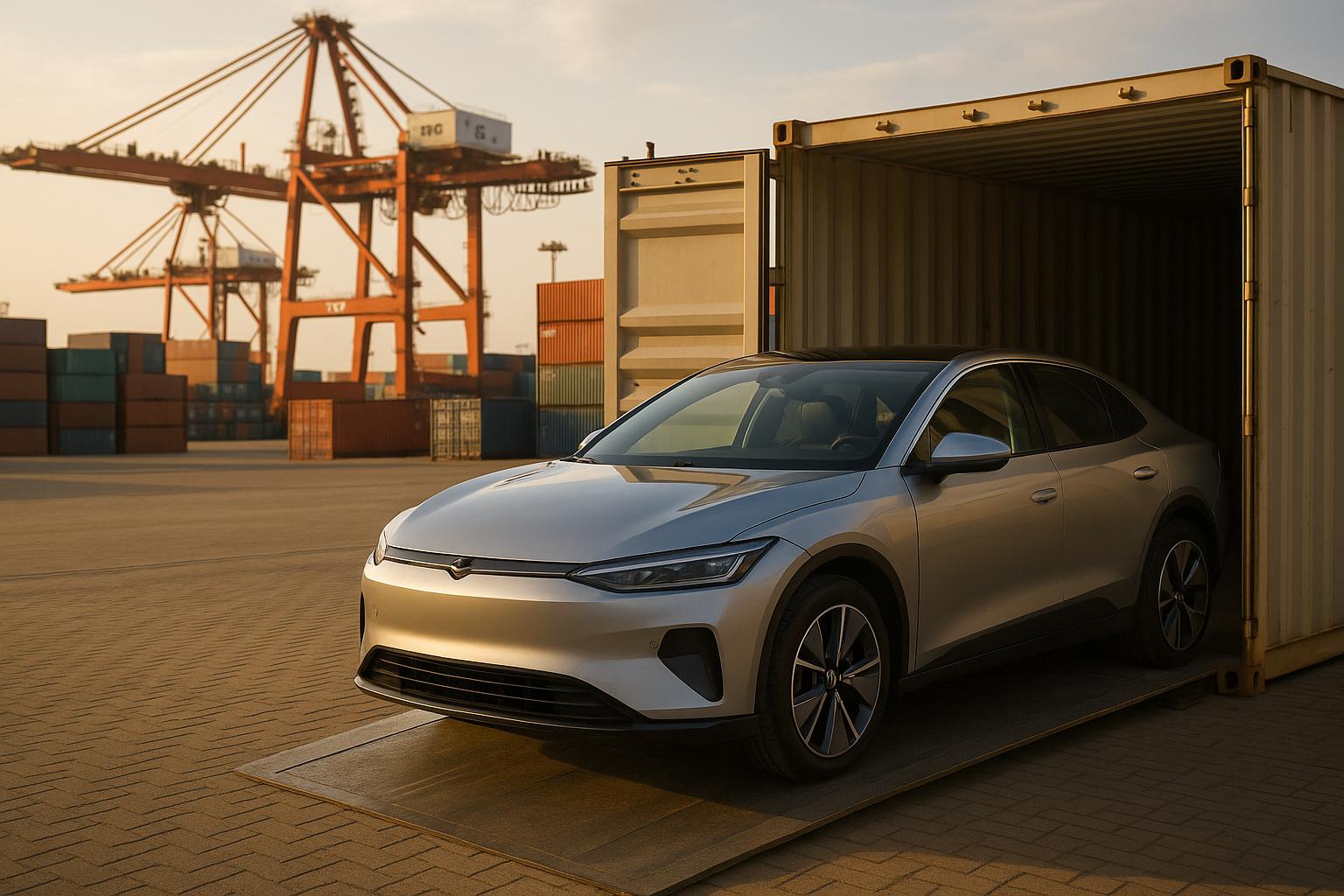
Importing electric vehicles (EVs) from China to Uganda in 2025 offers opportunities but requires careful planning. Here’s what you need to know:
- Why Import EVs to Uganda? Uganda is promoting EV adoption with growing charging infrastructure and incentives. EVs are cost-effective and require less maintenance compared to traditional vehicles.
- Why Source from China? China leads in EV production, offering affordable, high-tech options from brands like BYD and XPeng. With a 20% cost advantage over Western markets, Chinese EVs are ideal for Uganda.
- Key Steps:
- Find Reliable Suppliers: Look for manufacturers with certifications like ISO 9001 and strong export records.
- Understand Import Taxes: Uganda imposes a 25% import duty, VAT, and additional fees. Prepare for these costs.
- Shipping Logistics: Use sea freight via ports like Mombasa or Dar es Salaam. Container shipping is safer for EVs.
- Meet Local Standards: Ensure compliance with Uganda’s 15-year vehicle age limit, Euro 4 emissions regulations, and right-hand drive requirements.
- Registration: Complete customs clearance, inspections, and obtain roadworthiness certificates.
Platforms like EV24.africa simplify the process by connecting you with verified suppliers and logistics partners, ensuring a smoother import experience. By following these guidelines, you can successfully bring EVs to Uganda while navigating regulations and minimizing risks.
How to Import Electric Cars from China?
How to Find Reliable Electric Vehicle Suppliers in China
Choosing the right supplier in China’s extensive manufacturing landscape is crucial. The country is home to both top-tier manufacturers and less dependable trading companies. Finding a trustworthy partner ensures a smoother import process and guarantees consistent quality in the vehicles you source.
What to Look for in Reputable Suppliers
One of the first steps is to differentiate between manufacturers and trading companies. Manufacturers provide better visibility into the production process and tighter control over quality. Trading companies, while sometimes more flexible, add an extra layer between you and the production, which can complicate communication and quality assurance.
Check the supplier’s financial health and production capacity. Reliable suppliers should have the resources to handle large orders and navigate market fluctuations. Look for evidence of their production volumes, tooling timelines, and shipment lead times. Top suppliers often maintain on-time delivery rates exceeding 98%.
Certifications speak volumes about a supplier’s commitment to quality. Look for internationally recognized certifications like ISO 9001, IATF 16949, PPAP, RoHS, and REACH.
"Standards define what great looks like, setting consistent benchmarks for businesses and consumers alike – ensuring reliability, building trust, and simplifying choices." – International Organization for Standardization
However, it’s important to stay informed about industry trends. A 2024 study revealed an increase in quality issues with Chinese-made electric and plug-in hybrid vehicles, averaging 210 problems per 100 vehicles – 37 more than in 2023. Common complaints included unpleasant interior odors, excessive road noise, poor camera clarity, and unresponsive touchscreens. Interestingly, EVs made for domestic Chinese brands tend to have fewer issues compared to those produced for international brands. On the other hand, JD Power’s 2024 study highlighted that Chinese-made range-extended EVs were noted for their industry-leading quality.
When selecting a supplier, prioritize those with dedicated engineering teams, robust R&D capabilities, and services like failure analysis and inventory management. These features indicate proactive technical support and a commitment to customer needs. Additionally, ensure suppliers can respond to inquiries within 8 hours. Once you’ve confirmed their capabilities, gather all necessary documentation to validate their reliability.
Using EV24.africa for Verified Supplier Access
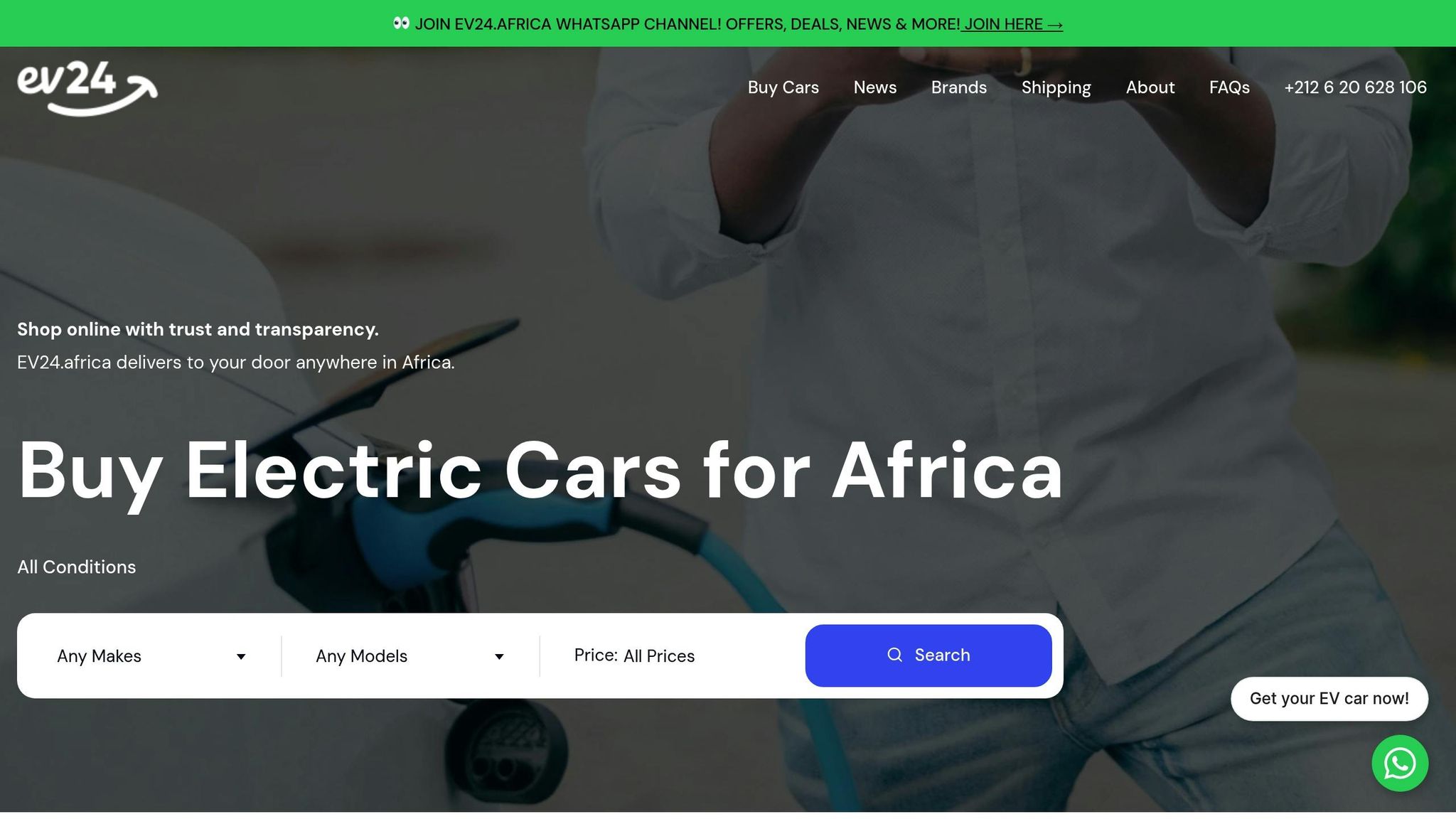
If you’re looking for a streamlined way to find trustworthy suppliers, EV24.africa is a valuable resource. This platform connects buyers with suppliers who have passed rigorous verification processes, ensuring they meet high standards.
The verification process at EV24.africa goes beyond basic checks. Suppliers are assessed on production capacity, quality certifications, and their track record with African exports. This is particularly important for meeting the unique requirements of Ugandan imports, such as right-hand drive configurations and adaptations for tropical climates.
The platform also provides transparent ratings and performance metrics. You can review data on delivery times, customer satisfaction, and reorder rates, giving you the confidence to make informed decisions without the guesswork typically involved in sourcing suppliers.
Required Documentation to Request from Suppliers
Securing the right documentation is essential for confirming a supplier’s legitimacy and ensuring a smooth import process. Before placing an order, request key documents such as business registration certificates, export licenses, and manufacturing certifications. Hesitation to provide these is a potential red flag.
For quality assurance, ask for detailed policies, Parts Per Million (PPM) defect rates, and evidence of internal testing procedures. Recent quality audit reports and testimonials from similar export projects can also provide valuable insights.
Product-specific certifications are non-negotiable, especially for compliance with Ugandan regulations. These should include certificates for international safety standards, emissions compliance, and electrical safety. For EVs, this typically involves battery safety certifications, approvals for charging systems, and electromagnetic compatibility documentation.
Financial stability is another critical factor. While full financial statements may not be necessary, ask for proof of their automotive business volume, major recent contracts, and export shipment insurance coverage.
To gain deeper insight into production quality, request sample reports and audit trails. Inspection reports from recent shipments, complete with photos of quality control and packaging processes, can help confirm their reliability.
Lastly, don’t overlook after-sales service agreements. These should cover warranty details, parts availability, technical support, and the locations of service centers. As Uganda’s EV infrastructure is still developing, strong after-sales support can make all the difference in avoiding unexpected challenges.
Uganda’s Import Regulations and Taxes for Electric Cars
Navigating Uganda’s import regulations is crucial for effective budgeting and ensuring a smooth customs process. The country has implemented updated policies that impact all vehicle imports, including electric vehicles (EVs), with strict compliance measures in place.
Import Taxes and Duties Breakdown
Uganda’s tax policy for EVs underwent a significant shift last year. The government reintroduced a 25% import duty on electric vehicles, hybrids, and electric motorcycles after briefly eliminating it during the 2023–2024 fiscal year. This policy change had a noticeable impact on the market – during the zero-duty period, EV imports surged to 420 units, compared to just 26 units when the tax was in place. Out of these, 403 units were hybrids, while 17 were fully electric.
In addition to the 25% import duty, importers should account for other costs, including VAT, excise duty, registration fees, and environmental levies. These charges vary based on the vehicle’s value and specifications.
| Tax/Fee Type | Rate/Amount | Notes |
|---|---|---|
| Import Duty | 25% | Applies to EVs, hybrids, and electric motorcycles |
| Value Added Tax (VAT) | Variable | Calculated based on vehicle value and specifications |
| Excise Duty | Variable | Determined by vehicle specifications |
| Registration Fees | Variable | Required for legal road use |
| Environmental Levies | Variable | Additional compliance costs |
To encourage local manufacturing, the government offers incentives for companies producing EVs, batteries, or charging equipment domestically. Businesses that meet criteria such as employing at least 80% local staff and achieving specific investment thresholds can benefit from Stamp Duty Tax exemptions for 2024/2025. Additionally, companies assembling electric two-wheelers locally enjoy import duty and VAT exemptions on components, along with a five-year income tax waiver.
Aside from tax considerations, Uganda enforces stringent rules on vehicle age and inspection to ensure compliance with local standards.
Vehicle Age and Inspection Requirements
Uganda has a strict 15-year age limit for imported vehicles, including EVs, calculated from the manufacturing date.
According to AutoMag.ug, "Uganda prohibits the importation of cars older than 15 years from the date of manufacture."
All imported vehicles must also undergo a Pre-Export Verification of Conformity (PVoC) inspection before shipping. The Uganda National Bureau of Standards (UNBS) oversees these inspections to ensure roadworthiness, emissions compliance, and adherence to local standards.
AutoMag.ug states, "The Uganda National Bureau of Standards (UNBS) is responsible for conducting pre-shipment inspections of imported vehicles to verify their roadworthiness, emissions levels, and compliance with Ugandan standards. Only vehicles that pass the inspection and certification process are allowed entry into Uganda."
Additional requirements include right-hand drive configurations for all vehicles, except for special-purpose ones. Uganda has also adopted Euro 4 emission standards under the National Environment (Air Quality Standards) Regulations of 2024, although enforcement levels may vary. Starting in July 2025, the country plans to implement annual vehicle inspections.
When importing from China, ensure your supplier can arrange the PVoC inspection and provide all necessary certifications before the vehicle is shipped.
Required Documentation and Compliance with Ugandan Authorities
Accurate documentation is essential to avoid border delays and streamline the registration process. The Uganda Revenue Authority (URA) and UNBS require several key documents to verify compliance. These include a commercial invoice, packing list, bill of lading or airway bill, certificate of origin from China, and a Certificate of Conformity (COC) to meet UNBS standards.
Financial documentation must include your Tax Identification Number (TIN) for URA processing, along with tax payment receipts and vehicle valuation documents for customs calculations. Personal identification, such as photocopies of your ID and passport, is also required.
For the vehicle itself, you’ll need the original logbook or export documents from China, as well as an insurance certificate for the imported vehicle. Depending on the type of EV, you may also need specific import permits.
The Certificate of Conformity is particularly important for electric vehicles, as it verifies compliance with Uganda’s technical and environmental standards. Collaborate with your supplier to ensure the certification meets all regulatory requirements.
Always keep both original and photocopied versions of your documents to ensure smooth customs processing. Missing or incomplete paperwork can lead to delays, so double-check all requirements with the URA before shipping your vehicle from China.
Shipping Logistics and Delivery from China to Uganda
Once you’ve secured your supplier and completed the necessary documentation, the next step is arranging delivery from China to Uganda. Since Uganda is a landlocked country, shipments often arrive at coastal ports like Mombasa in Kenya or Dar es Salaam in Tanzania before continuing overland to their destination. This routing plays a key role in determining the most practical shipping options.
Shipping Options and Costs
For importing electric vehicles, sea freight is typically the most cost-effective choice, offering two main methods. Full Container Load (FCL) is ideal for bulk imports or when partnering with other importers, while Less than Container Load (LCL) works well for single-vehicle shipments.
As SINO Shipping notes:
"Container shipping is not just a fleeting trend. Instead, it’s shaping up to be the future backbone of electric vehicle transportation."
This method not only optimizes shipping costs but also improves efficiency.
| Shipping Method | Transit Time | 2025 Cost Estimate | Best For |
|---|---|---|---|
| Sea Freight (20ft FCL) | 30–45 days | $2,850–$4,000 | 1–2 vehicles, bulk imports |
| Sea Freight (40ft FCL) | 30–45 days | $4,800–$6,500 | 3–4 vehicles, dealer imports |
| Sea Freight (LCL) | 35–42 days | $150–$250 per cubic meter + $650–$1,000 trucking fee | Single vehicle imports |
| Air Freight | 5–10 days | $4–$10 per kg | Urgent deliveries only |
These costs include inland trucking from the port to Uganda, which typically adds 5–10 days to the total transit time [27,29].
Key considerations for shipping electric vehicles (EVs):
- Lithium-ion batteries are classified as dangerous cargo, requiring additional regulations and fees.
- Some carriers mandate that batteries be below a specific charge level before accepting the shipment.
- While major Roll-on/Roll-off carriers are increasingly limiting bookings for used electric and hybrid vehicles, container shipping remains a reliable alternative without these restrictions.
To save on shipping costs, consider consolidating shipments with other importers during off-peak months like April through June or August. This strategy can cut shipping expenses by up to 25%. After choosing your shipping method, ensure smooth delivery by coordinating with experienced customs clearance partners.
Customs Clearance and Logistics Partners
Navigating customs clearance effectively requires working with professionals familiar with Uganda’s specific regulations for electric vehicles. Clearing and forwarding services help ensure compliance with legal requirements and streamline the often complex documentation process.
The customs clearance process involves:
- Submitting accurate customs declarations to the Uganda Revenue Authority (URA), detailing the vehicle’s nature, value, origin, and destination. Incorrect or incomplete information can lead to delays or penalties.
- Vehicle inspections by customs officials to verify the details against the declaration. Non-compliance may result in further inspections or even confiscation.
- Partnering with logistics providers that offer end-to-end services, including customs declarations, duty payments, vehicle inspections, transportation, warehousing, and final delivery.
Freight forwarders like SINO Shipping and Winsail Logistics specialize in managing export licenses and navigating customs for vehicle shipments from China – services often not covered by manufacturers [11,27]. It’s wise to gather detailed quotes from multiple logistics providers to account for all associated costs upfront.
How EV24.africa Simplifies Shipping
EV24.africa doesn’t just help you find suppliers; it also streamlines the shipping process. By connecting you with verified logistics partners, the platform ensures smooth coordination from departure to delivery. Its network includes experienced freight forwarders who specialize in transporting vehicles from China to Uganda.
One standout service is Delivered Duty Paid (DDP), which offers an all-inclusive logistics solution. Winsail Logistics explains:
"DDP (Delivered Duty Paid) offers a stress-free international trade solution, especially for African countries. With the DDP model, the freight forwarder will be fully responsible for the entire logistics chain of goods shipped from China to Uganda, including export customs declaration, international transportation, Uganda import customs clearance and prepayment of all taxes and fees".
DDP simplifies budgeting by providing a single price that covers freight, taxes, and customs clearance fees – eliminating unexpected costs. For example, DDP LCL rates for shipments from a Guangzhou warehouse to Kampala start at $980.00 for 1–4 cubic meters and $850.00 for shipments over 5 cubic meters.
EV24.africa also offers tracking tools and dedicated customer support, keeping you informed throughout the shipping process. From customs procedures to delivery schedules, you’ll have access to detailed updates and assistance to address any concerns promptly.
sbb-itb-99e19e3
Meeting Electric Vehicle Standards in Uganda
Bringing an electric vehicle (EV) into Uganda involves more than just shipping it over. To legally drive your EV, it must meet specific standards and comply with local regulations. Knowing these requirements beforehand can save time and help you avoid unnecessary complications.
Ugandan EV Standards and Requirements
Uganda enforces Euro 4/IV emission standards for all imported vehicles, including EVs. These standards, established by the East Africa Community in July 2022, were formally adopted into Uganda’s National Environment (Air Quality) Standards and Regulations in 2024.
Even though EVs don’t produce tailpipe emissions, they still need an official emission certification. This certification, along with verification of the vehicle’s identification details, is mandatory.
Looking ahead, Uganda is gearing up for stricter regulations. By 2030, vehicles will need to meet Euro 6/VI standards. Opting for EVs that already align with these advanced standards can help ensure compliance down the road. Additionally, annual inspections will begin in July 2025 to confirm vehicles continue to meet these emission requirements.
Rob de Jong, Head of the UNEP Mobility Unit, stresses the importance of these measures:
"Data from the real-world vehicle emissions measurement highlights the urgent need for regional EURO IV standards implementation. This will not only improve the quality of imported fleets but also help reduce air pollution in the city of Kampala and across the region."
The push for stricter standards is backed by data showing that over 50% of gasoline passenger cars in Kampala emit pollutants at levels below Euro certification standards. Once your EV meets these requirements, the next step is to navigate the registration process.
Registration Process for Imported EVs
After ensuring your EV complies with Ugandan standards, it needs to be registered with the appropriate authorities. If all the paperwork is in order, the registration process can be completed in under 24 hours.
Here’s a breakdown of the required documents:
| Required Document | Purpose | Validity Period |
|---|---|---|
| Form C18 (Import Declaration) | Confirms customs clearance | Permanent |
| URA Clearance Certificate | Verifies all duties have been paid | Permanent |
| Roadworthiness Certificate | Confirms the vehicle meets standards | 30 days |
| Form VR1 | Official registration application | Single use |
| Payment Receipts | Proof of fees paid | Permanent |
The process includes verifying customs clearance (using Form C18, the URA certificate, and receipts), obtaining a 30-day roadworthiness certificate from a URF-approved center, completing Form VR1, and paying the registration fees. Afterward, you can schedule an inspection and collect your number plates and registration certificate within 7–14 working days.
Keep in mind that light vehicles must undergo fitness tests every two years, while heavy commercial vehicles require annual inspections. Once registration is complete, the focus shifts to ensuring reliable after-sales support for your EV.
After-Sales Support and Service Networks
After registering your EV, building a dependable after-sales support network is essential for maintaining its performance and value. Many African markets, including Uganda, face challenges like limited availability of spare parts, a shortage of skilled mechanics, and restricted maintenance services.
These challenges have led some EV owners to resell their vehicles shortly after purchase due to difficulties in sourcing parts and services. To address this, consider partnering with suppliers that have established local networks. For example, in March 2025, BYD teamed up with Moenco to enhance spare parts supply and manufacturing in Ethiopia. Similarly, GAC Group partnered with Huajian Group in May 2025 to improve EV sales, charging infrastructure, and local assembly operations.
Here are some practical steps to ensure reliable after-sales support:
- Work with suppliers that have strong local partnerships.
- Join or create EV owner groups to share maintenance tips and tackle spare parts issues collectively.
- Explore training programs aimed at expanding the pool of certified EV mechanics. For instance, EV Automobiles in Nigeria has committed to training over 1,000 EV professionals within two years.
Governments in the region are also stepping in to support EV ecosystems. Ethiopia, for example, offers incentives like free or leased land to investors in EV after-sales services. Uganda may follow suit as EV adoption increases. In the meantime, plan for higher initial maintenance costs by budgeting for critical spare parts, which may need to be imported directly from countries like China. As Automart Africa points out:
"The availability of spare parts, EV maintenance services, and public charging infrastructure are still restricted."
For a smoother experience, platforms like EV24.africa can connect you with suppliers that have established service networks or partnerships in Uganda, reducing long-term maintenance risks and ensuring your EV investment is well-supported.
Tools and Strategies to Streamline the Import Process
Bringing an electric vehicle (EV) from China to Uganda involves thorough preparation to keep costs in check and avoid unnecessary delays.
Step-by-Step Import Checklist
Having a detailed checklist can help you stay on track and avoid missing critical steps. Typically, the entire process – from payment to delivery – takes about 4–8 weeks.
| Step Category | Key Actions for Import Checklist |
|---|---|
| 1. Supplier Selection & Vehicle Sourcing | – Research Uganda’s EV market demand and identify suitable models. – Choose a dependable EV supplier/exporter in China with expertise in vehicle exports. – Select an EV model that fits criteria like battery range, capacity, and after-sales support. – Check the vehicle’s quality, battery performance, safety features, mileage, and history. – Ensure the vehicle complies with Uganda’s age limit (15 years or newer) and road safety standards. – Acquire export licenses from China (usually handled by freight forwarders). |
| 2. Financial Planning & Payment | – Negotiate pricing and payment terms (e.g., bank transfer) with the supplier. – Calculate all costs, including the vehicle price, shipping, insurance, Ugandan duties/taxes, registration, and modifications. – Finalize payment, submit the original TT copy, and confirm the booking. |
| 3. Documentation Preparation | – Collect supplier documents: Commercial Invoice, Original Bill of Lading, Export Certificate, and vehicle logbook/export document. – Prepare importer documents for Uganda: Work Permit, Immigration Permit, Proof of Residence Change, Proof of Booking, Original Passport, and Tax Identification Number (TIN). – Create an inventory list for the vehicle and its electrical components. – Secure transit insurance. |
| 4. Shipping & Logistics | – Work with an experienced freight forwarder specializing in EV shipping to East Africa. – Ensure the EV is securely packaged and lashed in the container. – Track the shipment to ports like Mombasa (Kenya) or Dar es Salaam (Tanzania). – Arrange road transport from the port to Uganda. |
| 5. Ugandan Customs Clearance & Registration | – Hire a skilled clearing agent in Uganda. – Submit all required documents to the Uganda Revenue Authority (URA). – Pay applicable import duties and taxes. – Complete the mandatory Road Worthiness Inspection by JEVIC. – Have the clearing agent process URA vehicle registration online and obtain an acknowledgment number. – Get the vehicle’s number plates after approval. |
| 6. Post-Import Vehicle Preparation | – Schedule a full vehicle service upon arrival. – Inspect and replace worn tires and brakes. – Find a mechanic experienced with imported EV models. – Confirm warranty coverage and access to user manuals or technical support. |
Key cost factors include an Import Duty of 25% of the CIF value, VAT at 18%, Withholding Tax at 6%, an Environmental Levy (ranging from 20% for cars aged 5–10 years to 35% for cars over 10 years old), and URA Fees & Number Plates costing around UGX 1.3 million.
Using a detailed checklist and expert support can simplify the import process significantly.
Using EV24.africa’s Tools and Services
EV24.africa makes importing EVs easier by handling the entire process for you. The platform operates across all 54 African countries, including Uganda, using the Port of Mombasa in Kenya as a primary entry point before managing inland transportation.
With a team of over 200 professionals spread across five African countries and partnerships in over 40 nations, EV24.africa ensures smooth handling of imports. Their services include customs clearance, registration assistance, and managing import taxes, eliminating the need to juggle multiple service providers.
EV24.africa offers flexible delivery options, such as door-to-door or port-to-port services, based on your preferences. They adhere to Incoterms like Delivered Duty Paid (DDP) or Free on Board (FOB). Their network connects with suppliers from Europe, Asia (including China), North America, and Japan, offering both certified used and brand-new EVs.
"At EV24.africa, we take the headache out of importing new models like the BYD Seagull. We manage all the complicated logistics, from shipping to customs clearance, so you get a clear, final price with no nasty surprises."
This service eliminates the need to coordinate with freight forwarders, clearing agents, and documentation services, reducing complexity and minimizing errors.
How to Overcome Common Import Challenges
Even with a solid plan, challenges can arise during the import process. Addressing these issues proactively can save time and money.
Regulatory complexity is a common obstacle. Unlike the European Union, where uniform standards apply, East African countries like Uganda follow different regulations for public service vehicles, which can slow down growth and investment. To navigate this, work with clearing agents who specialize in Ugandan regulations and stay informed about any changes.
Logistical delays are another challenge, especially for landlocked countries like Uganda. While transporting goods from Kenya to Uganda should take about four days, customs activities at ports often extend this timeline to nearly 14 days. Build extra time into your schedule and maintain communication with logistics partners to manage these delays.
Infrastructure limitations also pose hurdles. Limited charging stations in many areas mean you’ll need to plan ahead. Look into existing charging networks or consider investing in battery-swapping services, which are gaining traction in African markets.
Financial barriers remain significant, as EVs often come with high upfront costs. However, Chinese EVs stand out as a cost-effective option – two-thirds of electric cars sold in China in 2024 were priced lower than their traditional counterparts, unlike the United States and Germany, where EVs remain more expensive.
Insurance gaps for EVs need attention too. The insurance market for EVs is still evolving, and policies often require adjustments to reflect local realities, driver behavior, and parts availability. Research insurance options early and choose providers experienced in EV coverage.
Knowledge gaps in the EV ecosystem can slow adoption. Supporting local training programs and connecting with EV communities can help build expertise. This creates opportunities for knowledge sharing and strengthens the support network for EV owners.
The African Continental Free Trade Area (AFCFTA) and the Pan-African Payment and Settlement System (PAPS) are promising developments that may reduce trade barriers and simplify payments in local currencies, potentially making future imports more cost-effective.
Conclusion
Bringing electric vehicles (EVs) from China to Uganda in 2025 demands thoughtful preparation and adherence to shifting regulations. The process starts with choosing a suitable right-hand drive model that meets Uganda’s 15-year age limit and planning the shipping route from coastal ports to Uganda, all while ensuring compliance with local rules.
Importers should prepare for costs including a 15% duty, 17% VAT, 2% commission, and 6% withholding tax on the dutiable value. Additionally, beginning February 1, 2025, all imports must be insured by Ugandan insurance companies. Non-compliance will incur a 1% penalty on the insured goods’ value.
Navigating these regulations is smoother with the help of experienced clearing agents who are up-to-date on current requirements. Speaking about the new insurance mandate, Mr. Charles Kareeba, Chairman of the Uganda Shippers Council, remarked:
"We realised that the same people selling goods were also the ones negotiating insurance, which resulted in unnecessary expenses."
Once regulatory and financial steps are addressed, the focus shifts to shipping logistics. Container shipping is the preferred method for fully assembled EVs, offering better protection compared to roll-on/roll-off methods. Chinese brands like BYD, Geely, Neta, Changan, and Wuling offer competitive options, along with growing local after-sales support.
Success also depends on accurate documentation, including certificates, invoices, and permits, as well as passing the mandatory JEVIC roadworthiness inspection.
For those seeking a streamlined experience, EV24.africa simplifies the process by connecting importers with verified suppliers and dependable logistics partners. Their transparent pricing and coordinated services ensure a smoother journey, building on the supplier verification process highlighted earlier.
With the right planning and resources, importing EVs from China to Uganda in 2025 can be a profitable and manageable endeavor.
FAQs
What should I consider when choosing a trustworthy electric vehicle supplier in China for importing to Uganda?
When choosing a trustworthy EV supplier in China for importing to Uganda, it’s crucial to confirm that they meet international electric vehicle standards and hold the necessary certifications. This ensures the vehicles are both safe and high-quality. Focus on suppliers with a solid reputation, substantial experience in exporting to Africa, and a history of providing certified, authentic vehicles.
It’s also wise to work with suppliers who offer clear pricing, reliable shipping solutions, and strong after-sales support. These factors can reduce potential risks and make the importation process much smoother. Investing time in researching and communicating with suppliers upfront can help you avoid unexpected issues later.
What steps should I take to ensure the electric car I import meets Uganda’s regulations and environmental standards?
To bring an electric vehicle (EV) into Uganda in 2025, you’ll need to ensure it meets the country’s regulations and environmental standards. Start by confirming that the EV complies with Uganda’s safety, emissions, and performance requirements. This involves inspections by the Uganda National Bureau of Standards (UNBS) to verify battery safety and adherence to environmental guidelines.
Another key factor is the vehicle’s age – Uganda has strict rules, allowing imports only if the car is less than 15 years old. Gather all the required documentation and double-check compliance with import regulations to avoid unnecessary delays, fines, or potential legal issues. Following these steps not only simplifies the import process but also supports responsible environmental practices.
How can I lower shipping costs and ensure smooth customs clearance when importing electric cars from China to Uganda?
To keep shipping costs down, opting for sea freight, like a full container load (FCL), is often a more budget-friendly choice compared to air freight. Planning your shipments well ahead of time can also save you from expensive last-minute transportation charges. Additionally, combining shipments and lowering volumetric weight are effective strategies for trimming costs.
When it comes to customs clearance, working with an experienced customs broker is highly advisable. They can guide you through Uganda’s import regulations, help prevent delays, and ensure all necessary documentation is in order. Being well-prepared with accurate paperwork and a clear understanding of Uganda’s tax and duty requirements is essential for a smooth and stress-free process.


